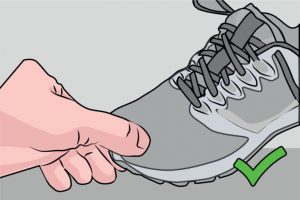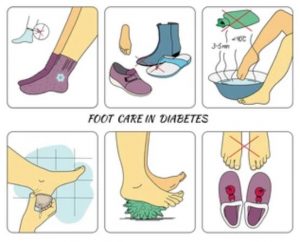Diabetic Foot — Ways to keep away from
Persistent high blood sugar or repeated blood sugar fluctuations in diabetic patients can cause foot blood vessels and neuropathy, causing serious consequences. So what should be paid attention to in diabetic foot care?
Why is there a diabetic foot due to poor blood sugar control?
If blood sugar is not well controlled, the chances of serious complications for sugar lovers will increase dramatically. Among them, diabetic foot is the most common and more serious complication. Continuous high blood sugar or repeated blood sugar fluctuations can cause foot blood vessels and neuropathy, causing serious consequences.
Blood vessels are channels for transporting nutrients and immune cells and substances. Vascular disease of the foot can cause a lack of nutrition in the foot tissues and reduce the speed of the accumulation of immune cells and substances after the foot is injured. In this case, if a wound or ulcer occurs on the foot, infection and gangrene are easy to occur, and it is difficult to cure.
Neuropathy will weaken the skin’s ability to perceive the outside world, and often feel pain when walking. This is the same principle as when we squat for a long time and press on the nerves of the feet and feel the tingling. In addition, nerve damage in the feet will cause sugar lovers to lack the necessary perception of temperature and injury. Even if the feet are stimulated, they will not avoid them in time, which will further increase the chance of injury and infection.
Sugar issue people need to take good care of their feet to prevent diabetic feet. If it is not handled well, it may require amputation or even death.

Which sugar issue people should pay special attention to preventing diabetic feet?
Sugar issue people with poor blood sugar control are prone to complications including diabetic feet. This is the law of iron. In addition, if the following symptoms occur, the risk of a diabetic foot can be further judged.
Cold and swelling of the lower limbs, accompanied by numbness, pain or dullness, or even disappear;
Decreased or disappeared pulsation of blood vessels in the dorsum of the foot;
When the feet are drooping, the color will gradually become purple-red;
There is no obvious discomfort when you are not walking, but you will feel soreness and discomfort when you walk, and you have to stop and rest;
Changes in the bones and muscles of the foot, such as muscle atrophy, foot deformities, etc.
If a sugar issue person finds one of the above conditions, it is recommended to see a doctor in time and get treatment as soon as possible. If the above problems have not yet occurred, don’t think that there is absolutely no possibility that you will get sick. If you don’t pay attention, there may still be a risk of diabetic foot.

I already have a diabetic foot, what should I do?
Diabetic foot is easy to prevent and hard to treat. If a diabetic foot has already occurred, treatment options are very limited, and sometimes amputation is required. To avoid falling into such a dilemma, sugar issue people must pay attention to the care of the feet under the premise of good blood sugar control, and pay attention to the following details in life.
(1) It is not a joke to know how to wash your feet
Washing your feet with water and soap at a suitable temperature every day can prevent infection to a certain extent. However, due to nerve damage in the feet, some sugar issues people are not sensitive to heat and cold, and they often get scalded when the water temperature is too high. Therefore, when washing your feet, do not test the water temperature directly with your feet. Ask your family to do it for you or use a more sensitive hand to test the water temperature to control the water temperature at about 37°C.
After washing the feet, dry the back of the feet, soles of the feet, especially between the toes, to avoid breeding pathogenic bacteria. But don’t use too much force when wiping your feet with a towel, so as not to artificially scratch your skin. It is best to use a white, soft cotton dry towel to wipe it, it has good water absorption, and it is easier to find whether there are blood or pus stains. In addition, it is also a good way to dry your feet with a small wind from a hairdryer.
Wash your feet for 10-20 minutes each time. If your feet have broken skin, bullae, or burns, don’t wash your feet first.

(2) Reduce foot skin damage and avoid infection
In addition to washing the feet, another key thing in foot care is to avoid foot injuries and prevent secondary infections. This requires attention to the following things:
Wear suitable shoes, not too tight or too hard. Every day, check whether there is sand, foreign bodies, toenail chips, etc. in the shoes and whether the insoles are flat. The shoe size should fit your feet. Don’t wear new shoes for too long, and don’t walk long distances right away to avoid rubbing your feet and causing foot injuries. Don’t wear “human” slippers to avoid friction and damage between the thumb and index finger of the foot.
Wear sweat-absorbing and sterilizing socks to create a relatively hygienic foot space. After suffering from a diabetic foot, the blood vessels of the foot cannot quickly gather immune cells and substances, and the immunity will decrease. If the sweat secreted on the skin surface of the feet cannot be absorbed in time, the possibility of bacterial growth will increase, and the chance of secondary infection will increase. In addition, socks should be looser. If it is too tight, it will hinder the already unsmooth foot blood flow. Try a few more styles until you find the socks that suit you best.
Keep the skin of the feet soft and moisturized to prevent chapped. Use lotions or other skincare products to prevent dry and cracked foot skin, which can reduce the risk of infection.
Trim your toenails regularly. Regularly trimming your nails can help prevent minor foot injuries, but avoid cutting to the corners of the toes or other cuts. If it is not easy to trim, you can use a nail file or emery. If you find a problem with your toenails, you should see a doctor in time to prevent infection.
Don’t walk barefoot. Because diabetes can cause nerve damage, the patient’s feet will be very insensitive, so it is very likely that they will not notice pebbles or other things while walking and will be injured, which may lead to serious infections.
Pay attention to keeping your feet warm, rather than relying on external heat sources for heating. Keep your feet warm in winter, avoid snow entering your feet, try not to use hot water bottles, kettles, or electric blankets to warm your feet, and do not put your feet in front of electric heaters to avoid burns caused by dullness.

